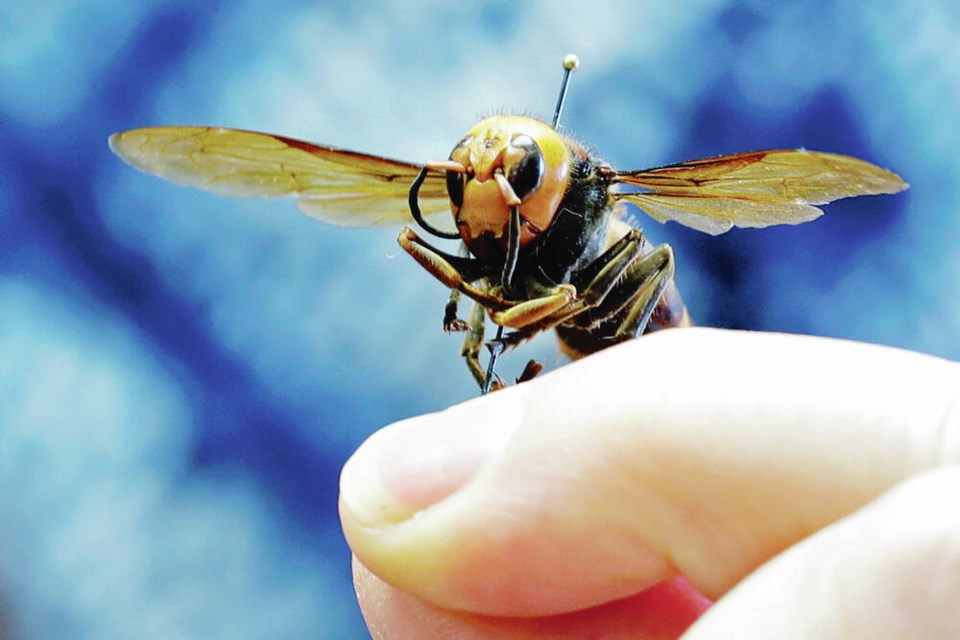A new sex bait being developed in the U.S. and described as irresistible to the Asian giant hornet could be a useful tool in eradication of the invasive species, says B.C.’s chief apiculturist.
Paul van Westendorp said using sex pheromones from queens of the so-called “murder hornets” will attract male hornets, although not the females that lay all the eggs, establish nests and are potentially out right now searching for carbohydrates to start building colonies.
Placed in traps, however, pheromones will reduce populations and help in locating potential nests, said van Westendorp.
Researchers at the University of California in San Diego have been testing the powerful pheromones in traps and results show it’s impossible for males to resist.
“It will be an effective tool in control,” said van Westendorp, who cautioned there is still research to do on the stability of the pheromones outside a lab setting.
Washington and British Columbia are both planning renewed trapping this spring to catch and track the Asian giant hornets, which prey on honeybees and can destroy a bee hive in a matter of hours.
Officials at Washington’s Department of Agriculture said trapping is underway with no catches so far. B.C. will start its trapping program May 1 by concentrating on traps laced with fruit juice and fermenting grapes, from White Rock to Aldergrove in the Fraser Valley, close to the U.S. border.
Van Westendorp said dozens of other traps are also being set by beekeepers and citizen scientists, municipal governments and parks staff and other agencies throughout the summer and fall.
Washington’s trapping programs will focus on areas in Whatcom County where Asian giant hornets have been found over the past three years. Residents in Whatcom, Skagit, San Juan, Island, Jefferson and Clallam counties are being encouraged to participate in citizen scientist trapping efforts.
Van Westendorp said Vancouver Island is considered free of the Asian giant hornets since a group of Nanaimo beekeepers discovered and destroyed Canada’s first nest in the roots of a tree in a park in the fall of 2019. No specimens or sightings have been found or reported since then.
The giant hornets are the world’s largest hornets at about five centimetres long and capable of speeds of more than 30 kilometres per hour. They pack a walloping sting with venom that feels like “red-hot thumbtacks going into the flesh,” according to Conrad Berube, a bee specialist who was stung seven times while destroying the Nanaimo nest.
In Washington state, giant-hornet hunters found and destroyed their a nest in October 2020, using vacuums to capture 500 of the hornets, including 200 “virgin queens,” from a tree on a residential property just a few metres from a children’s swing set in Blaine, Washington. Some of the capsules that contained the queens were empty, raising concerns they had already left to develop new hives.
Officials in Washington said the giant hornets found in Nanaimo in 2019 were genetically linked to giant hornets from Japan. The hornets collected in Washington were traced to hornets from South Korea, using DNA.
Van Westendorp said three other colonies were discovered and destroyed in Washington state last year.
They were genetically the same, as was the only specimen found last year in B.C. — in the Fraser Valley — and the six collected in the Fraser Valley in 2020.
Scientists have not pinpointed how the hornets got here, although it’s believed they hitchhiked on cargo ships from Asia.
Barring any new introductions, van Westendorp believes the narrowing genetic diversity of the populations could help curb the hornets’ expansion. He said high in-breeding poses a serious threat to the survivability of populations, adding “nature doesn’t like that.”
He said the U.S. has more worries about a southerly expansion into Oregon and California, where climates are more favourable for the hornets, which prefer warmer weather.
Van Westendorp said Canadian apiculturists are also watching the destructive spread of another invasive hornet. The yellow-legged Asian hornet, Vespa velutina nigrithorax, was accidentally introduced in France from China in 2003 and is now wreaking havoc on honeybees across Europe.
He said the European Union has spent more than 20 million euros to combat the species, which is smaller than the murder hornet but equally aggressive.
Scientists say it is spreading faster every year and into cooler climates as it moves northward in Europe.
“Its predatory behaviour is a great threat,” said van Westendorp.
TIPS DEALING WITH ASIAN GIANT HORNETS
• If you find a nest, do not disturb it. Leave the area.
• Stings are rare but could occur if the nest is disturbed.
• Because of the larger amount of venom injected, a sting can be very painful and cause localized swelling, redness and itching.
• Treat a sting similar to wasp or bee stings by putting ice or a cold compress on the site to reduce inflammation and spread of venom.
• Do not rub the site because it will spread venom.
• People who are stung multiple times (10 or more) have a higher risk of developing toxic or allergic reactions, lightheadedness or dizziness.
• People who are stung multiple time or who develop symptoms of toxic or allergic reactions are advised to seek medical attention immediately.
• If you think you’ve spotted an Asian giant hornet, call the Invasive Species Council of B.C. at 1-888-933-3722, or report it via the council’s “Report Invasives” mobile phone app.



